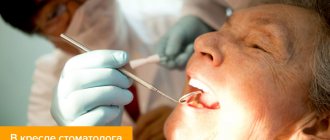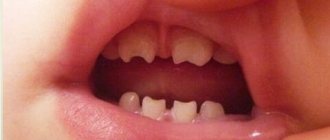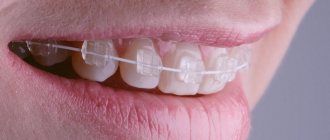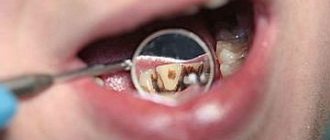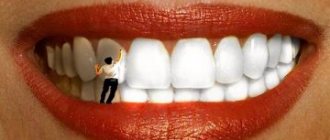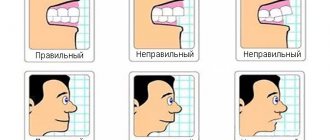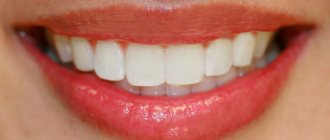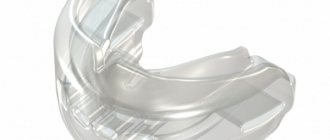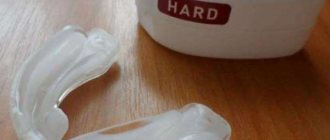What is retention
Retention is a delay in the growth of baby or molar teeth. With this pathology, the tooth may erupt, but not completely, but can be barely visible above the gum, and it can also grow only under the gum, not showing out at all. First of all, this disease affects the second premolars and third molars located on the lower jaw, as well as the canines of the upper jaw. Maxillary canine impaction is much more common in women. This pathology can occur on one side of the jaw or on both sides at once. Canine impaction in the lower jaw is a very rare occurrence. Impaction of primary teeth is also extremely rare. Such disorders in children can be caused by an acute lack of vitamins in the body or serious pathologies during teething. Impaction of primary teeth can be caused by severe rickets.
Symptoms and diagnosis
This deviation has visual signs, so a good dentist will detect hyperdontia at the first manifestations. Signals that may indicate supernumerary teeth in a child:
- speech defects (lisp, swallowing sounds);
- displacement of the dentition, malocclusion;
- slowing down the appearance of molars;
- malfunction of the gastrointestinal tract;
- rotation of healthy teeth around their axis.
Extra teeth have weak and crooked roots. They grow in an abnormal order, and the shape can be different, mainly in the form of a cone. Size is smaller than that of healthy people. Parents manage to detect hyperdontia when the central incisors erupt. To confirm or refute your guess, visit your dentist.
Family Dentistry will take an x-ray or perform a 3D tomography to determine the location of extra teeth and their exact number.
Types of pathology
Teeth eruption disorders can be of two types: complete and partial, and the tooth, respectively, impacted and semi-impacted. The last type means that the tooth has erupted a little, i.e. visually observed above the gum. The impacted tooth is completely hidden by the gum and is not accessible to palpation. According to the depth of their occurrence, such teeth can be tissue embedded (the tooth is located in the gum tissue) or bone embedded (lies in the jaw bone). Such teeth can be located:
- Angularly, i.e. at an angle.
- Vertical.
- Horizontally.
Sometimes there are so-called reverse impacted teeth, most often these are the lower eighth teeth. In such teeth, the upper part is turned towards the jaw, and the roots are turned towards the alveolar edge. There are also symmetrical, unilateral or bilateral tooth retention.
Treatment of supernumerary teeth in children
Babies sometimes develop their first extra teeth immediately after birth. In this case, breastfeeding is a difficult test - the mother's nipple is constantly injured, and the baby's mucous membrane is damaged. In this situation, the teeth need to be removed urgently. If the supernumerary tooth erupted during the period when the child’s milk teeth were not replaced by molars, it will be removed. And to correct the bite, the intervention of an orthodontist will be required.
Difficulties arise if the extra tooth turns out to be impacted or semi-impacted - that is, it did not erupt and remained under the gum. Then dentists will prescribe special procedures:
- vibration stimulation;
- stimulating massage;
- electrical stimulation.
This will help speed up teething. Then the dentists decide whether to remove such a tooth or leave it. Sometimes doctors decide to save extra teeth if they do not interfere with the remaining teeth erupting in their place and do not spoil the bite. Modern techniques quickly solve the problem of hyperdontia if you consult a doctor at an early stage. Therefore, Family Dentistry specialists recommend visiting the dentist twice a year and teaching children to do this from an early age.
Why does a canine or molar not appear?
The concept of retention refers to the anatomical specificity of the jaw or an anomaly in the formation of the tooth germ. Experts believe that this pathology arose in modern society as a result of eating too soft food, i.e. people have practically stopped chewing solid food. Other reasons why retention may occur:
- improper feeding of the child;
- reduced immunity associated with exposure to infections;
- delay in replacing milk teeth with molars;
- the presence of supernumerary teeth that prevent the eruption of a permanent tooth;
- incorrect location of the permanent tooth germ in the jaw bone. With this pathology, the crown of the tooth is directed towards the root of the adjacent tooth, thereby preventing its appearance and the eruption of neighboring teeth;
- bad heredity.
Reasons for retention
Most often, the reason for the development of retention is associated with the incorrect location of neighboring teeth, which become an obstacle to the eruption of retention teeth. In other cases, the problem may be due to too dense bone or gum tissue.
Other factors influencing the development of pathology include the following phenomena:
- supernumerary (abnormally large number of teeth),
- diseases of internal organs, which leads to disruption of the full development of the entire skeletal system,
- loss of baby teeth at too early an age,
- genetic predisposition.
The main symptoms of the pathology
Retention in dentistry is quite common, and there are some signs by which this pathology can be detected:
- pain in the gums, radiating to the ear and temporal part;
- regular injury to the same place in the oral mucosa;
- numbness and swelling;
- painful sensations when opening the mouth and while chewing food;
- mobility or displacement of teeth;
- deterioration of general health due to the inflammatory process (fever, weakness, chills, etc.);
- the appearance of a cyst or abscess.
Polyodontia is an abnormal number of teeth.
In medicine, this disease is often called hyperdontia, and “extra” dental elements are called supernumerary teeth. Research is still being conducted into why this pathology occurs. Most scientists associate it with disturbances in the formation of tooth germs.
Nature provides that a person grows no more than 20 milk teeth and 32 permanent teeth in a lifetime, but exceptions occur, and in our time quite often. According to statistics, on average, dental anomalies occur in 2% of the world's population, most often in men.
In 2014 alone, two operations were performed, in one of which 80 teeth were removed, and in the other, a record 232 teeth. Until this time, the maximum figure was 37 teeth.
The most common hyperdontia (anomaly in the number of teeth) is an anomaly of the upper incisors. Supernumerary teeth are less common among the lower incisors and in other parts of the jaw. They can come in a wide variety of shapes and sizes. These are usually small, cone-shaped teeth.
Extra teeth lead to deformation of the dentition, so it is recommended to remove supernumerary elements. Another reason for removal is that most patients with this pathology have a lisp.
The formation of extra teeth is quite common today. According to statistics, 70% of patients have only one extra incisor, in 25% of cases – 2 supernumerary elements, and only 5% of all patients have 3 or more teeth during examination.
Elimination of anomaly
Treatment of retention is a rather complex process that requires qualified assistance from dentists of several specializations. Treatment is selected individually for each patient and depends on the clinical picture of the oral cavity. The first question that a dentist needs to decide is whether to remove or save a diseased tooth. There are several treatment methods, most often this is a surgical intervention in which a specialist cuts the gingival hood so that nothing prevents the tooth from erupting outward. Surgical procedures of this kind are used in situations where the tooth grows correctly and does not interfere with neighboring teeth. In other cases, most often, the tooth is removed. Removing an impacted tooth is a rather difficult operation. The procedure is carried out under local anesthesia, after which the gum is cut, and the specialist uses a bur to create access to the tooth, after which it is completely removed. Then a special medicine is placed into the tooth socket. If necessary, sutures are applied and removed ten days after the procedure. Swelling may occur after removal of an impacted tooth. Most often, after removing such a tooth, the doctor prescribes antibiotics and painkillers. Also, the patient, for the first few days, needs to stop eating solid foods, hot and cold foods and drinks.
Causes of hyperdontia
There is no consensus among experts about the reasons for the appearance of extra teeth. There are several versions:
- hyperdontia is a manifestation of atavism;
- the embryonic plate has split into too many tooth germs;
- genetic and hereditary factor.
It is not possible to prevent hyperdontia, so we recommend that parents pay more attention to the dentist’s findings. Timely measures are a guarantee of successful treatment.
Symptoms of hyperdontia in adults
Polyodontia affects permanent teeth more often than baby teeth. An adult usually develops dystopic and impacted supernumerary teeth.
Dystopic teeth are those that appear outside the dental arch. Most often they erupt on the lingual surface of the gums and in the palate. With this form of the disease, the patient typically:
- poor pronunciation of sounds;
- noticeable malocclusion;
- change in the usual arrangement of teeth: curvature of the angle at which they grow, as well as their rotation
- around its axis;
- frequent injury to the oral mucosa and, as a result, its inflammation;
- disruption of chewing processes, resulting in digestive problems.
Among other things, dystopic teeth often cause psychological problems. Due to a non-aesthetic, and sometimes completely unattractive smile, the patient becomes withdrawn and uncommunicative. Psychological problems, in turn, cause chronic diseases of the endocrine, digestive and nervous systems.
Impacted supernumerary teeth are teeth that do not erupt, but continue to remain in the bone tissue of the human jaw. Often they hardly make themselves felt until complications begin. Dentists diagnose this anomaly during a routine examination of the patient.
This abnormality in the number of teeth is accompanied by the following symptoms:
- normal teeth begin to loosen (the condition is considered pathological);
- the bone begins to protrude (if the impacted tooth is too close to the edge of the jaw);
- Aching pains appear periodically.
One of the most difficult situations is when extra teeth grow in place of impacted third molars. Wisdom teeth cannot grow and begin to negatively affect the roots of other teeth, which in turn can lead to serious complications.
Symptoms of the disease in children
The first supernumerary teeth in children appear before birth or in the first six months of life. The main inconvenience they cause is difficulty in feeding.
Polyodontia of primary teeth in older children occurs with symptoms similar to the eruption of regular teeth. In this case it is observed:
- temperature increase;
- swelling of the gums in the place where the tooth should erupt;
- pain;
- excessive salivation;
- swelling of the nasal mucosa;
- loose stool.
Symptoms are especially severe when extra teeth appear in the upper palate.
If hyperdontia makes itself felt in a two-year-old child, this can interfere with the formation of normal speech. In turn, due to injury to the tongue and mucous membranes, some kind of inflammation constantly appears in the oral cavity.
When supernumerary teeth appear in very noticeable places in school-age children, ridicule towards the patient may occur, which is fraught with the development of psychological problems and complexes in the future.
Prevention after surgery
The rehabilitation period after removal of an impacted wisdom tooth lasts longer than after a normal one. Healing of the gum socket can take up to 2-3 weeks. During this period, it is important to follow the doctor's recommendations to prevent complications. It is necessary to carefully but delicately carry out hygienic care of the oral cavity. For the first days after the intervention, take painkillers and follow a gentle diet. Too hard, burning foods can damage the gums and cause tissue inflammation.
Dentists also recommend rinsing the mouth after each meal using antiseptic solutions, herbal decoctions, or just water. During the week, you must avoid physical activity, visiting the gym, baths, saunas. If any complications occur, you should not self-medicate; you must immediately seek help from a doctor.
If it hurts, what should you do?
In case of acute pain in the area of the impacted tooth or after extraction, you can take an anesthetic. For this purpose, non-steroidal anti-inflammatory drugs are best suited - Nimessil, Ibuprofen, Paracetamol, Ketanov. At home, you can also carry out hygienic cleaning and rinsing the mouth with antiseptics. For a professional examination and treatment, you must visit a dentist.
Types of polyodontia disease
Polyodontia in the oral cavity manifests itself in different ways. By studying the statistics, signs and symptoms of the disease, dentists were able to classify the types of this anomaly.
Depending on the origin, the disease is divided into two types:
- False polyodontia. Provides for a baby tooth that does not fall out, regardless of the person’s age. At the same time, it fulfills its functions, does not create discomfort to the bite, and is firmly fixed in the patient’s jaw. In addition, teeth fused together and other anomalies are classified as a false type of disease.
- True polyodontia. It can be caused by genetic predisposition, as well as terogenic factors. At the same time, extra molars begin to form in the human jaw.
Indications for removal
Retention can manifest itself as a stage of eruption. Over time, the crown completely appears above the gum and the tooth can function normally. Therefore, the decision on the need for removal should be made by a doctor only after examining and diagnosing the condition of the dental system. Indications for surgery are the following clinical cases:
- Constant pain;
- Complications of eruption;
- Trauma to an adjacent molar;
- Pressure on the dentition and its deformation;
- Horizontal or angular position of the third molar in the jaw;
- Dental crowding, which can be aggravated by wisdom teeth;
- Orthodontic and orthopedic indications, that is, the need for extraction to correct the bite or prosthetics.
Why is retention dangerous?
A partially erupted tooth is covered with a “hood” of adjacent tissues, under which food debris collects and colonies of pathogenic microflora develop, which can provoke purulent inflammation. With complete retention, another problem arises: a tooth embedded in the tissues constantly affects its “neighbor,” causing it to move from its correct position. The situation may sooner or later become more complicated:
- caries of adjacent teeth and resorption of their roots;
- malocclusion, crowded teeth and other dental anomalies;
- pulpitis and periodontitis;
- periodontal cyst;
- pericoronitis (inflammation of the gingival “hood”) and its complication, periostitis;
- purulent lymphadenitis;
- inflammation of the trigeminal nerve;
- abscess and phlegmon.
Therefore, when diagnosing retention, the patient is offered the optimal way to solve the problem.
What can be done about an impacted tooth?
- According to indications, based on the general clinical situation, removal of an impacted wisdom tooth may be recommended (especially for patients undergoing treatment with braces for an abnormal bite).
- In some cases, not accompanied by obvious problems, when removal is not necessary, the doctor will suggest observing the tooth.
- Healthy impacted incisors and canines located in the smile zone, subject to certain conditions, can be “pulled out” from the dental tissues and returned to the dentition.
